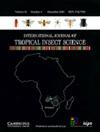Understanding the ability of Pachycrepoideus vindemiae (Hymenoptera: Pteromalidae) to find and parasitize buried Diptera pupae in southwestern Colombia
IF 1.2
4区 农林科学
Q3 ENTOMOLOGY
International Journal of Tropical Insect Science
Pub Date : 2023-11-14
DOI:10.1007/s42690-023-01118-z
引用次数: 0
Abstract
Abstract Pachycrepoideus vindemiae is a generalist wasp parasitoid released for biological control of the pupal stage for several species of Tephritoidea and Muscoidea flies that limit production of fruits and poultry commodities, respectively, worldwide. The parasitoid wasp must find buried host pupae to oviposit on them, and several factors may influence this outcome. The objectives of this study were to determine the capacity of first, host larvae to burrow to pupate according to substrate humidity and second, the parasitoid wasp to burrow and parasitize buried host pupae according to different conditions (substrate type, host species and parasitization time exposure). Moreover, comparison of chemical profiles between host’s pupae potentially involved for host location by the parasitoid was realized by GC-FID. Peat humidity significantly affected the burrowing depth of Dasiops inedulis and Anastrepha striata and both species buried significantly deeper in peat with 50% humidity than in dry conditions. The number of emerged parasitoids is not different between the two tested host species . P. vindemiae performance was better in peat than in crop soil. In peat wasps’ parasitism is similar between buried pupae located at 0 mm or 10 mm depth regardless of the time of exposure to the parasitoid. Cuticular chemical profiles showed that the four-host pupa species studied did not share compounds. However, A. striata shared some compounds with D. inedulis and, M. domestica shared some with C. capitata. Common compounds were found in the extracts of parasitized and non-parasitized pupae of C . capitata , D . inedulis and M . domestica .了解哥伦比亚西南部厚茧蜂(膜翅目:羽蛾科)发现和寄生埋在地下的双翅目蛹的能力
vindeiae Pachycrepoideus vindeiae是一种广泛的寄生蜂,在世界范围内对几种分别限制水果和家禽产品生产的软蝇科和蝇科蝇进行蛹期生物控制。寄生蜂必须找到埋藏的寄主蛹在其上产卵,有几个因素可能影响这一结果。本研究的目的是首先根据基质湿度确定寄主幼虫挖洞化蛹的能力,其次根据不同条件(基质类型、寄主种类和寄生时间暴露)确定拟寄生蜂挖洞寄生寄主蛹的能力。此外,还利用气相色谱- fid对寄生蜂可能参与寄主定位的寄主蛹的化学成分进行了比较。泥炭湿度显著影响了稻纵花和纹条树的挖洞深度,在湿度为50%的泥炭条件下,这两种植物在泥炭中的埋深都显著高于干燥条件。出现的寄生蜂数量在两种被试寄主之间没有差异。在泥炭土壤中,白僵菌的生长性能优于在作物土壤中。在泥炭中,无论暴露于寄生蜂的时间如何,埋在0 mm或10 mm深的蛹之间的寄生性是相似的。表皮化学特征表明,所研究的四种寄主蛹没有共同的化合物。然而,纹条家蝇与黄毛家蝇有一些共同的化合物,家蝇与金毛家蝇有一些共同的化合物。寄生蛹和未寄生蛹的提取物中发现了共同的化合物。首府,D。inedulis和M。有明显。
本文章由计算机程序翻译,如有差异,请以英文原文为准。
求助全文
约1分钟内获得全文
求助全文
来源期刊

International Journal of Tropical Insect Science
ENTOMOLOGY-
CiteScore
2.40
自引率
8.30%
发文量
212
期刊介绍:
International Journal of Tropical Insect Science is the only journal devoted exclusively to the latest research in tropical and sub-tropical insect science. Each issue brings you original, peer-reviewed research findings on tropical insects and related arthropods, with special emphasis on their environmentally benign and sustainable management.
The Journal"s scope includes arthropod ecology and biodiversity, ethno-entomology, arthropod taxonomy, integrated pest and vector management, and environmental issues. The Journal publishes research papers, short communications and scientific notes. The Journal also includes reports of meetings and obituaries of prominent scientists, book reviews, and review and mini-review articles that are normally submitted at the invitation of the Editors.
 求助内容:
求助内容: 应助结果提醒方式:
应助结果提醒方式:


